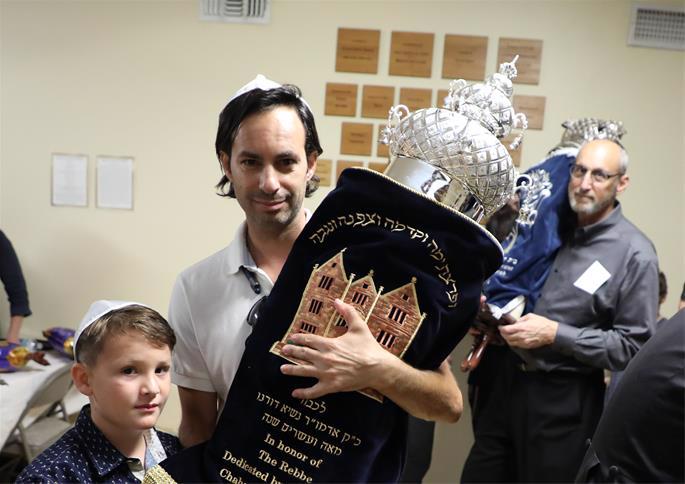
The joyous climax of Simchat Torah is the dancing of hakafot (lit. “circles”), during which we dance and sing with the Torah scrolls. In the words of one Chassidic master, “On Simchat Torah the Torah scrolls wish to dance, so we become their feet.”
The hakafot are a memorable event, certainly one of the highlights on the Jewish calendar. It is a kid-friendly event; they should not be left at home! And you might want to pass on those uncomfortable formal dancing shoes for this participatory event; the comfortable shoes (though they should be elegant in honor of the holiday) will probably be more suitable for the occasion.
The Chassidic masters explain that the Torahs are rolled shut and wrapped in their velvet coverings for the duration of the hakafot celebrations. We don’t celebrate by sitting down and studying the Torah’s holy words. This is because the celebration encompasses every Jew, no matter his or her level of Torah scholarship or ability to comprehend and interpret the Torah’s words. The Torah is the heritage of every Jew – the day-old infant is as essentially connected to the Torah as the venerated sage – and every Jew is equally entitled to celebrate on this special day.
The Hakafot—Step-by-Step
The hakafot are celebrated on the eve of Simchat Torah and then again the following morning. In Chassidic communities, hakafot are also conducted on the eve of Shemini Atzeret. The evening hakafot follow the amidah of the night’s festive prayers; the morning hakafot immediately precede the reading of the (final parshah of the) Torah.
Print the Complete Hakafot Service (PDF)
Before the dancing commences, a set of seventeen verses, called Atah Ha’raita, is chanted three times. Traditionally, members of the congregation are honored with leading the congregation in the recitation of these verses; in synagogues where there are many more congregants than verses, it is common practice to “auction off” the honors, with the proceeds going to charity.
After the completion of the Atah Ha’raita, it is Chabad custom, as instituted by the Rebbe, to chant the following verse (Genesis 28:14): “And your seed shall be as the dust of the earth, and you shall gain strength westward and eastward and northward and southward; and through you shall be blessed all the families of the earth and through your seed.”
All the Torah scrolls are then removed from the Ark. According to the Zohar, the Torahs’ crowns should not be removed, but should remain on the scrolls throughout the dancing.
The Torahs’ crowns should not be removed, but should remain on the scrolls throughout the dancing.
Members of the congregation are honored with holding the scrolls (a Torah scroll should always be held over the right shoulder), and the leader leads the Torah procession around the bimah (synagogue reading table) while chanting brief prayers beseeching G‑d for success and deliverance, with the congregation responding in kind. This is followed by singing and dancing, with the Torah scrolls usually handed from person to person, allowing all the opportunity to be the “Torah’s feet.” The children, too, take part in the merry-making, traditionally dancing around with special Simchat Torah flags, and are often treated to a bird’s eye view of the dancing while perched on their dancing father’s shoulders. In the spirit of merriment, it is not unusual to find some adults enjoying a l’chaimor two before and during the hakafot.
This procedure is followed seven times—seven hakafot. After each hakafah (singular term for hakafot), the synagogue’s gabbai (beadle) announces, “Ad kan hakafah ….” (“We have reached the conclusion of hakafah number x”), the Torahs are returned to the ark, and the next hakafah commences (usually with a different set of people holding the Torahs, and a different leader).
The procedure for the hakafot on Simchat Torah morning is slightly different. According to Chabad custom, three and a half circuits are made around the bimah, with the prayers for each hakafah being recited during the course of a half of a circuit. All the seven hakafot areperformed in succession with no interruption (the gabbai does not announce “Ad kan...”), and then are followed by one prolonged session of singing and dancing with the Torah.
